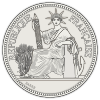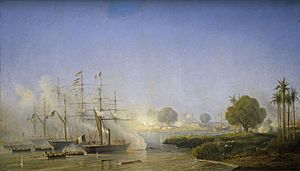French Cochinchina facts for kids
Quick facts for kids
Colony of Cochinchina
|
|||||||||||||||
|---|---|---|---|---|---|---|---|---|---|---|---|---|---|---|---|
| 1862–1949 | |||||||||||||||
|
|
|||||||||||||||
|
Anthem: "La Marseillaise"
|
|||||||||||||||

Cochinchina in 1920
|
|||||||||||||||
| Status | Occupied territory of France (1858–1862) Colony of France (1862–1949) Constituent territory of French Indochina (1887–1949) |
||||||||||||||
| Capital | Saigon (1862–1931) Saigon–Cholon (1931–1949) |
||||||||||||||
| Common languages | French Vietnamese Khmer Chinese |
||||||||||||||
| Religion | Buddhism Confucianism Taoism Catholicism Animism Caodaism Hòa Hảo Islam |
||||||||||||||
| Demonym(s) | Cochinchinese | ||||||||||||||
| Government | Colonial administration (1858–1946) Autonomous Republic (1946–1949) |
||||||||||||||
| Governor | |||||||||||||||
|
• 1858–1859
|
Charles Rigault de Genouilly | ||||||||||||||
|
• 1947–1949
|
Pierre Boyer De LaTour du Moulin | ||||||||||||||
| Historical era | New Imperialism | ||||||||||||||
|
• Capture of Saigon
|
17 February 1859 | ||||||||||||||
|
• Ceded by Đại Nam
|
5 June 1862 | ||||||||||||||
|
• Part of French Indochina
|
17 October 1887 | ||||||||||||||
|
• Japanese occupation
|
28 July 1941 | ||||||||||||||
|
• Proclamation of Independence of the Democratic Republic of Vietnam
|
2 September 1945 | ||||||||||||||
|
• "Autonomous Republic of Cochinchina"
|
1 June 1946 | ||||||||||||||
|
• Merged to the Central Government
|
4 June 1949 | ||||||||||||||
| Population | |||||||||||||||
|
• 1920
|
3,800,000 | ||||||||||||||
| Currency | Vietnamese văn (1862–1945) Cochinchina piastre (1878–1885) French Indochinese piastre (1885–1949) |
||||||||||||||
|
|||||||||||||||
| Today part of | Vietnam | ||||||||||||||
French Cochinchina was a colony of French Indochina. It covered the southern part of Vietnam from 1862 to 1949. The French set up large farms, mostly for growing rubber.
After Japan left in 1945, the French created the "Autonomous Republic of Cochinchina." This decision caused problems and helped start the First Indochina War. In 1949, Cochinchina joined with other parts of Vietnam to form the State of Vietnam. This was part of the French Union.
The name Nam Kỳ was used by the Vietnamese Nguyễn dynasty. However, it became strongly linked to French rule. Because of this, many Vietnamese people, especially those who wanted independence, preferred to use Nam Phần to talk about Southern Vietnam.
History of French Cochinchina
How France Took Control
In 1858, France attacked Tourane (now Da Nang) in Vietnam. They said they were protecting French Catholic missionaries. These missionaries were seen as a threat by the Vietnamese Nguyễn dynasty. French Admiral Charles Rigault de Genouilly, with help from Spanish forces, then attacked Saigon in 1859.
The Vietnamese army surrounded Saigon, but French forces broke the siege in 1861. In 1862, Vietnam signed the Treaty of Saigon. This treaty allowed Catholics to practice their religion freely. It also opened the Mekong Delta and three northern ports for trade. Vietnam gave France three provinces: Biên Hòa, Gia Định, and Định Tường, plus some islands.
In 1867, French Admiral Pierre de la Grandière forced Vietnam to give up three more provinces. These were Châu Đốc, Hà Tiên, and Vĩnh Long. With these additions, all of southern Vietnam and the Mekong Delta came under French control.
France Strengthens Its Power
By 1871, all the lands France took in southern Vietnam became the colony of Cochinchina. Admiral Dupré was its first governor.
In 1887, Cochinchina joined the Union of French Indochina. Unlike other areas like Annam and Tonkin, Cochinchina was directly ruled by France. This meant French officials made all the decisions. Cochinchina even had a representative in the French National Assembly in Paris.
Cochinchina had the largest number of Europeans in Indochina. By 1940, about 16,550 Europeans lived there, mostly in Saigon.
Farming and Rubber Plantations
The French government took land from Vietnamese farmers and landowners. This was to make sure Europeans controlled the growing of rice and rubber. By 1930, the French controlled over a quarter of Cochinchina's farmland. However, Vietnamese landowners still owned most of the farms and rice production in the Mekong Delta.
France started growing rubber in Cochinchina in 1907. They wanted to earn money like the British did from their rubber farms in Malaya. The French government encouraged investment by giving away large areas of land. These lands were used for big rubber farms. Forests in eastern Cochinchina were cleared for these new crops.
These changes led to unrest, including the 1916 Cochinchina uprising. People tried to attack the Saigon prison and fought back in the Mekong Delta. As rubber demand grew after World War I, European farms hired workers from other parts of Vietnam. These workers brought new ideas about independence.
Local farmers also faced problems. They were forced into debt and had to work on plantations because of land and poll taxes. By 1930, a small number of landowners owned most of the rice fields. Many people had no land and worked on large farms. This caused many protests and strikes. One important strike was at a large Michelin rubber farm in 1930.
Between 1930 and 1932, the French government arrested many political prisoners. Many faced harsh punishments or were sent to work in prison camps.
Japanese Occupation During World War II
In September 1940, Japanese forces moved into northern Vietnam (Tonkin). An agreement was made with the French government. It allowed France to keep control of its army and government, but Japanese forces could use Indochina to fight the Allies.
In July 1941, about 140,000 Japanese troops moved into southern French Indochina. This was to prepare for an invasion of the oil-rich Dutch East Indies. French troops and officials were allowed to stay, but under Japanese watch. The Japanese tried to keep peace, but their presence created tension. This led to stronger feelings for Vietnamese independence.
From 1943, the Japanese started to support Vietnamese nationalist groups in Cochinchina. In March 1945, Japan took full control, arresting European officials. This ended 80 years of French colonial rule. In August 1945, as Japan faced defeat, they created a puppet state called the Empire of Vietnam. Cochinchina became part of it, under Emperor Bảo Đại.
The August Revolution and French Return
On September 2, 1945, Ho Chi Minh declared Vietnam's independence in Hanoi. His group, the Viet Minh, formed a temporary government in Saigon on August 24. When British troops arrived to disarm the Japanese, other Vietnamese groups also appeared.
In September 1945, the Viet Minh used their youth groups to control crowds in Cần Thơ. They fired on people asking for weapons against the French. In Saigon, the return of French rule, helped by British and Japanese troops, led to a big uprising on September 23. This was called the Southern Resistance War. The Viet Minh fought against other resistance groups. By the end of 1945, they were pushed out of cities into the countryside.
Joining the State of Vietnam
On June 1, 1946, while Viet Minh leaders were in France for talks, the French created an "Autonomous Republic" in Cochinchina. This went against an earlier agreement and led to war between France and the Viet Minh. Nguyễn Văn Thinh was the first leader of this new government, but he died that year.
Later, Nguyễn Văn Xuân became the leader. He renamed it the "Provisional Government of Southern Vietnam." He wanted to reunite all of Vietnam. The next year, the Provisional Central Government of Vietnam was formed by joining Annam and Tonkin. Xuân became its Prime Minister.
Cochinchina remained separate for over a year. Former Emperor Bảo Đại refused to return to Vietnam as head of state until the country was fully reunited. On March 14, 1949, the French National Assembly voted to create a new assembly for Cochinchina. This assembly was elected on April 10, 1949, with Vietnamese representatives becoming the majority.
On April 23, the assembly approved joining the Provisional Government of Southern Vietnam with the Provisional Central Government of Vietnam. The French National Assembly approved this on May 20, and the merger happened on June 4. The State of Vietnam was then created, with Bảo Đại as its leader.
How Cochinchina Was Governed
Government Structure
After France took control, Vietnamese officials left Cochinchina. This meant the French had to rule directly. The top leader was the Governor of Cochinchina. After 1887, this governor reported to the Governor-General of French Indochina. Since Cochinchina was a direct colony, French officials managed everything, from provinces down to small villages.
Each province in Cochinchina had a French official called "Chủ tỉnh" or "Tỉnh trưởng." These officials had similar duties to French officials in other Vietnamese provinces. Provinces were divided into districts called "Tong," led by a "Chanh tong." Districts were further divided into villages called "xã," led by a "Huong ca." Both district and village leaders were paid by the French government.
Laws and Justice
In the early days of French rule, both French laws and old Vietnamese laws were used. French people were tried under French laws, and Vietnamese people were tried under Vietnamese laws. The French courts used both legal systems. But after France fully took control, Vietnamese laws were removed. Only French laws applied to everyone in the colony.
On January 6, 1903, the Governor-General of French Indochina, Jean Baptiste Paul Beau, made a new rule. It said that all crimes, whether by French or local people, would go to French courts. People would only be tried under French Cochinchina's law code. During this time, new laws were also made to fine people for common offenses outside of the main law code.
Gallery
See also
 In Spanish: Cochinchina francesa para niños
In Spanish: Cochinchina francesa para niños
- Cochinchina
- French Indochina
- Protectorate of Annam
- Protectorate of Tonkin
- List of administrators of the French colony of Cochinchina
- List of French possessions and colonies
- State of Vietnam













